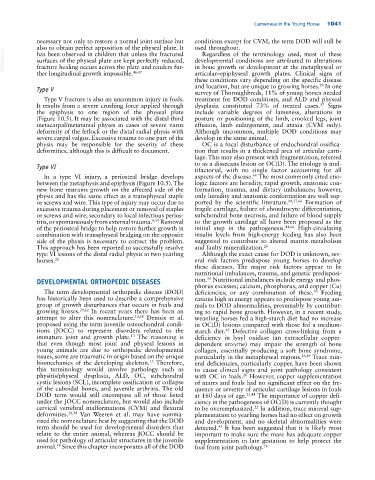Page 1075 - Adams and Stashak's Lameness in Horses, 7th Edition
P. 1075
Lameness in the Young Horse 1041
necessary not only to restore a normal joint surface but conditions except for CVM, the term DOD will still be
also to obtain perfect apposition of the physeal plate. It used throughout.
VetBooks.ir surfaces of the physeal plate are kept perfectly reduced, developmental conditions are attributed to alterations
Regardless of the terminology used, most of these
has been observed in children that unless the fractured
fracture healing occurs across the plate and renders fur
in bone growth or development at the metaphyseal or
ther longitudinal growth impossible. 46,47 articular–epiphyseal growth plates. Clinical signs of
these conditions vary depending on the specific disease
29
Type V and location, but are unique to growing horses. In one
survey of Thoroughbreds, 11% of young horses needed
Type V fracture is also an uncommon injury in foals. treatment for DOD conditions, and ALD and physeal
It results from a severe crushing force applied through dysplasia constituted 73% of treated cases. Signs
37
the epiphysis to one region of the physeal plate include variable degrees of lameness, alterations in
(Figure 10.5). It may be associated with the distal third posture or positioning of the limb, crooked legs, joint
metacarpal/metatarsal physes in cases of severe varus effusion, limb enlargement, and ataxia (CVM only).
deformity of the fetlock or the distal radial physis with Although uncommon, multiple DOD conditions may
severe carpal valgus. Excessive trauma to one part of the develop in the same animal.
physis may be responsible for the severity of these OC is a focal disturbance of endochondral ossifica
deformities, although this is difficult to document. tion that results in a thickened area of articular carti
lage. This may also present with fragmentation, referred
Type VI to as a dissecans lesion or OC(D). The etiology is mul
tifactorial, with no single factor accounting for all
In a type VI injury, a periosteal bridge develops aspects of the disease. The most commonly cited etio
66
between the metaphysis and epiphysis (Figure 10.5). The logic factors are heredity, rapid growth, anatomic con
new bone restrains growth on the affected side of the formation, trauma, and dietary imbalances; however,
physis and has the same effect as a transphyseal staple only heredity and anatomic conformation are well sup
or screws and wire. This type of injury may occur due to ported by the scientific literature. 49,57,66 Formation of
excessive trauma during placement or removal of staples fragile cartilage, failure of chondrocyte differentiation,
or screws and wire, secondary to local infectious perios subchondral bone necrosis, and failure of blood supply
titis, or spontaneously from external trauma. 4,55 Removal to the growth cartilage all have been proposed as the
of the periosteal bridge to help restore further growth in initial step in the pathogenesis. 41,66 High‐circulating
combination with transphyseal bridging on the opposite insulin levels from high‐energy feeding has also been
side of the physis is necessary to correct the problem. suggested to contribute to altered matrix metabolism
This approach has been reported to successfully resolve and faulty mineralization. 28
type VI lesions of the distal radial physis in two yearling Although the exact cause for DOD is unknown, sev
horses. 21 eral risk factors predispose young horses to develop
these diseases. The major risk factors appear to be
nutritional imbalances, trauma, and genetic predisposi
50
DEVELOPMENTAL ORTHOPEDIC DISEASES tion. Nutritional imbalances include energy and phos
phorus excesses; calcium, phosphorus, and copper (Cu)
The term developmental orthopedic disease (DOD) deficiencies; or any combination of these. Feeding
50
has historically been used to describe a comprehensive rations high in energy appears to predispose young ani
group of growth disturbances that occurs in foals and mals to DOD abnormalities, presumably by contribut
growing horses. 29,62 In recent years there has been an ing to rapid bone growth. However, in a recent study,
attempt to alter this nomenclature. 13,58 Denoix et al. weanling horses fed a high‐starch diet had no increase
proposed using the term juvenile osteochondral condi in OC(D) lesions compared with those fed a medium‐
tions (JOCC) to represent disorders related to the starch diet. Defective collagen cross‐linking from a
43
immature joint and growth plate. The reasoning is deficiency in lysyl oxidase (an extracellular copper‐
13
that even though most joint and physeal lesions in dependent enzyme) may impair the strength of bone
young animals are due to orthopedic developmental collagen, essentially producing a soft bone syndrome,
issues, some are traumatic in origin based on the unique particularly in the metaphyseal regions. 26,49 Trace min
biomechanics of the developing skeleton. Therefore, eral deficiencies, particularly copper, have been shown
13
this terminology would involve pathology such as to cause clinical signs and joint pathology consistent
physitis/physeal dysplasia, ALD, OC, subchondral with OC in foals. However, copper supplementation
26
cystic lesions (SCL), incomplete ossification or collapse of mares and foals had no significant effect on the fre
of the cuboidal bones, and juvenile arthritis. The old quency or severity of articular cartilage lesions in foals
DOD term would still encompass all of those listed at 160 days of age. 22,44 The importance of copper defi
under the JOCC nomenclature, but would also include ciency in the pathogenesis of OC(D) is currently thought
cervical vertebral malformations (CVM) and flexural to be overemphasized. In addition, trace mineral sup
22
deformities. 29,58 Van Weeren et al. may have summa plementation to yearling horses had no effect on growth
rized the nomenclature best by suggesting that the DOD and development, and no skeletal abnormalities were
term should be used for developmental disorders that detected. It has been suggested that it is likely most
43
relate to the entire animal, whereas JOCC should be important to make sure the mare has adequate copper
used for pathology of articular structures in the juvenile supplementation in late gestation to help protect the
58
animal. Since this chapter incorporates all of the DOD foal from joint pathology. 58

